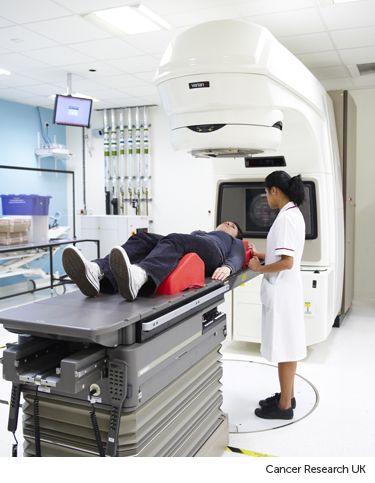Having radiotherapy for laryngeal cancer
You have your radiotherapy treatment for laryngeal cancer in the hospital radiotherapy department.
You have the treatment broken up into a course of smaller dose treatments called fractions. You usually have a fraction every day, from Monday to Friday, with a rest at the weekend.
You usually have a type of radiotherapy called intensity modulated radiotherapy (IMRT) for laryngeal cancer. IMRT directs a precisely targeted dose of radiation to the area of the tumour from outside the body.
The radiotherapy room
Radiotherapy machines are very big and could make you feel nervous when you see them for the first time. The machine might be fixed in one position. Or it might rotate around your body to give treatment from different directions. The machine doesn't touch you at any point.
Before your first treatment, your  will explain what you will see and hear. In some departments, the treatment rooms have docks for you to plug in music players. So, you can listen to your own music while you have treatment.
will explain what you will see and hear. In some departments, the treatment rooms have docks for you to plug in music players. So, you can listen to your own music while you have treatment.

It is important to lie in the same position each time, so the radiographers may take a little while to position you on the couch and attach your mask to the couch. They make sure your mask feels comfortable.
Once you are in the right position the staff leave you alone in the room.
During the treatment
You need to lie very still. Your radiographers might take images (x-rays or scans) before your treatment to make sure that you're in the right position. The machine makes whirring and beeping sounds. You won’t feel anything when you have the treatment.
Your radiographers can see and hear you on a CCTV screen in the next room. They can talk to you over an intercom and might ask you to hold your breath or take shallow breaths at times. You can also talk to them through the intercom or raise your hand if you need to stop or if you're uncomfortable.
The treatment can take between 15 to 30 minutes.
Daniel (radiographer): Before your treatment starts your doctor will need to work out exactly where the treatment needs to go and also which parts need to be avoided by the treatment.
To have radiotherapy you lie in the same position as you did for your planning scans.
To stop you moving and to make sure your treatment is directed at the cancer you wear a custom mask over your face which is attached to the couch.
We line up the machine using marks on your mask and then leave the room. We control the machine from a separate room this is so we aren’t exposed to radiation.
Treatment takes a few minutes and you’ll be able to talk to us using an intercom. We can see you and hear you while you’re having treatment and we will check that you’re OK.
When your treatment starts you won’t feel anything. You may hear the machine as it moves around you giving the treatment from different angles.
Because we’re aiming to give the same treatment to the same part of the body every day the treatment process is exactly the same everyday so you shouldn’t really notice any difference.
You’ll see someone from the team caring for you once a week while you’re having treatment. They’ll ask how you are and ask about any side effects.
You won't be radioactive
This type of radiotherapy won't make you radioactive. It's safe to be around other people, including pregnant women and children.
Travelling to radiotherapy appointments
You might have to travel a long way each day for your radiotherapy. This depends on where your nearest cancer centre is. This can make you very tired, especially if you have side effects from the treatment.
You can ask the  for an appointment time to suit you. They will do their best, but some departments might be very busy. Some radiotherapy departments are open from 7 am till 9 pm.
for an appointment time to suit you. They will do their best, but some departments might be very busy. Some radiotherapy departments are open from 7 am till 9 pm.
Car parking can be difficult at hospitals. Ask the radiotherapy staff if you are able to get free parking or discounted parking. They may be able to give you tips on free places to park nearby.
Hospital transport may be available if you have no other way to get to the hospital. But it might not always be at convenient times. It is usually for people who struggle to use public transport or have any other illnesses or disabilities. You might need to arrange hospital transport yourself.
Some people are able to claim back a refund for healthcare travel costs. This is based on the type of appointment and whether you claim certain benefits. Ask the radiotherapy staff for more information about this and hospital transport.
Some hospitals have their own drivers and local charities might offer hospital transport. So do ask if any help is available in your area.
Side effects
Radiotherapy for laryngeal cancer can make you make feel tired. You might also have a dry mouth and a sore throat.



